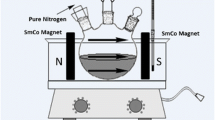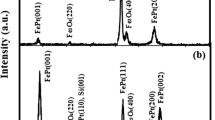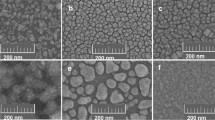Abstract
Annealing is one of the stages of FePt nanoparticles preparation, during which the transition to a compositionally ordered phase occurs. In order to size and shape control of the nanoparticles in the mentioned stage, it is needed that they be distributed on a suitable surface. In the present work, the spin-coating method is suggested for preparing monolayer from L12-FePt3 nanoparticles colloidal solution on SiO2/Si substrates. FePt3 nanoparticles were gradually deposited as droplets on the center of a 500 rpm rotating substrate. This step was performed in hexane vapor atmosphere without any stopping time. The analyses revealed that a uniform surface distribution was formed so that, after annealing at 600 °C for 1 h the 6.1 nm L12-FePt3 nanoparticles were spherical in shape with standard deviation of 1.5 nm.
Similar content being viewed by others
Avoid common mistakes on your manuscript.
Introduction
The fabricated Fe1–xPtx nanocrystals have chemically disordered FCC cubic structure [1] and by annealing them at temperature of 600 °C, depending on x, one of the two L10 or L12 chemically ordered phase is formed [2]. For 0.35 < x < 0.55, a ferromagnetic fct-L10 phase with high coercivity (Hc) can be achieved [3, 4]. Antiferromagnetic Fcc-L12 is the other ordered phase, i.e., FePt3 [5], for 0.55 < x < 0.80. Because of agglomeration and, therefore, deformation and size increase [3], it is required that nanoparticles to be distributed on the substrate by a suitable method. To prepare a uniform surface distribution of size-controlled monosize L10 or L12-FePt nanoparticles, some techniques have been suggested.
In thin film deposition by sputtering method, the growth of FePt layer grains is performed through a columnar manner [6]. However, the size, shape and surface distribution of nanoparticles are not completely suitable [7]. Monosize FePt nanoparticles are fabricated through chemical reduction methods [8]. After purification, the nanoparticles can be deposited on the surface. The fabrication of the L10-FePt nanoparticles with a polyethilenimine (PEI) layer has been reported in Ref. [9]. Dip coating is an alternative method that gives rise to a multilayer formation [10].
In the spin-coating (SC) method, at first nanoparticles should be fabricated and purified. Then, they are dispersed within a suitable solvent as a colloid solution [11]. In general, for their fabrication, a chemical reduction method such as polyol method is used [8]. Then, the nanoparticles are purified and distributed within a suitable solvent such as hexane, with oleic acid and olylamine as ligands [12]. In SC method, by taking account of the solution, substrate and coating parameters, there are several factors which affect the microstructure and nanostructure of the monolayer.
One advantage of the spin-coating method, besides monolayer formation from monosize nanoparticles, is its simplicity in usage [13]. To improve the microstructure and nanostructure of the fabricated layer, it is necessary that some parameters to be controlled. For example, the increase in the concentration of FePt colloidal solution leads to creation of a thick layer [14]. High evaporation rate of hexane solvent is a problem. So, to control its evaporation, the coating should be performed in hexane vapor atmosphere [13, 14]. In addition, the mixture of hexane and octane solvents can be used together [13]. Surface wettability and the bonds formed between particles and surface and also between particles should be taken into account [15].
SC method is a nonequilibrium method and the controllable aspects of crystallization of colloidal solution have not yet been found [13–16]. Islands formation and surface holes are typical problems of SC method [13, 15].
In this work, FePt nanoparticles are synthesized via polyol method. Then, after purification, the nanoparticles are dispersed within hexane; the solution has been coated on SiO2/Si substrate by the SC method. By analyzing our results, in order to fabricate a uniform surface dispersion from suitable size L12-FePt3 nanoparticles, some suggestions have been presented.
Experimental
FePt nanoparticles were synthesized via polyol method, by chemical co-reduction of Fe(acac)3 and Pt(acac)2 compounds, using a reducing agent [17, 18]. The mixture was heated up to 250 °C under an N2 atmosphere followed by refluxing at 250 °C for 30 min. To stabilize and control the size of the nanoparticles, oleic acid and oleylamine were used as ligands [19]. After cooling down to the room temperature, purification was accomplished by ethanol, through centrifugation at 10,000 rpm for 12 min, in two stages consecutively [17]. Afterward, the nanoparticles were dispersed in hexane and renewed surfactants, and then the final centrifugation was done.
To form a layer, it is required that Si surface to be converted to SiO2. So, the Si substrates were firstly cleaned by acetone, then placed under a flow of O2 atmosphere with the rate of 3 ml/s. The temperature was increased up to 890 °C and kept for 1 h before cooling down to the room temperature. The SiO2 layer caused a bonding formation between surface and FePt3 nanoparticles. After formation of SiO2, the SC process in hexane vapor atmosphere was performed. Colloidal solution of nanoparticles with concentration of 0.5 mg/ml was dropped on the SiO2/Si substrates. Hexane vapor atmosphere was used to reduce the evaporation rate and to generate uniform layers.
Some SC conditions chosen for our samples were as follows:
Sample 1 was coated in air by three droplets (0.1 ml) of nanoparticle solutions in wetting organic solvents such as hexane and octane, dropping on the substrate without any simultaneous rotation.
Sample 2 was coated in hexane vapor atmosphere by three droplets of solution with hexane as solvent, dropping on substrate without any simultaneous rotation.
For Sample 3, three droplets of solution of sample 1 were dropped on the substrate in hexane atmosphere, and then after 1 min the substrate was rotated at 400 rpm.
For Sample 4, at first the substrate was rotating at 500 rpm. Then, in hexane atmosphere, during time intervals of 1.5 min, six droplets of solution of sample 2 were dropped on the rotating substrate periodically.
After coating, the samples were placed in a furnace and were exposed to a flow of a gas mixture of 90 % Ar and 10 % H2 at a rate of 5 ml/s. Then, the temperature was increased up to 600 °C at the rate of 5 °C/min and kept at that temperature for 1 h. At that temperature, nanoparticles transformed to the L12-FePt3 ordered phase which has been realized from the results of analysis.
The TEM image was recorded using a PHLIPS system, model CM30, working at 300 kV, which revealed the size distribution of synthesized nanoparticles. X-ray diffraction was performed using an STOE diffractometer with Cu-Kα source \( (\lambda = 1.5405 \dot{A})\), which revealed the crystalline structure of the nanoparticles, after transition to the L12 ordered phase. The surface morphology was investigated by AFM analysis using SPM Park Scientific Instruments Auto probe CP model on contact mode. The FE-SEM images were recorded using model MIRA3 TESCAN working at 15.0 kV, which revealed the microstructure and nanostructure of the constructed layers, after annealing. Elemental analysis such as EDX was performed by a system, attached to the same microscope, by which the composition stoichiometry of the samples was determined. From these results, different size dispersions of nanoparticles and their final shapes on the SiO2/Si will be specified.
Results and discussion
Figure 1 shows the TEM image and the histogram of synthesized and purified nanoparticles. The nanoparticles are spherical with a mean diameter of 2.5 nm with the standard deviation of 1 nm. A stable solution was formed by adding oleic acid and oleylamine ligands and hexane solvent.
Figure 2 shows the result of the EDX analysis. The peaks of Pt and Fe elements imply the existence of these elements with atomic percentage of 12.46 % Fe and 63.02 % Pt. The trace of the substrate has been revealed by 24.52 % Si. Therefore, the synthesized composition is of FePt3 type nanoparticles [20].
Figure 3 shows the result of the X-ray diffraction of FePt3 nanoparticles after coating and annealing. The sharp peak at 2θ = 33° indicates the presence of silicon on the substrate. The (001), (110), (111), (200) and (201) peaks belong to the FCC cubic structure of the FePt3 with L12-compositional order [2, 4], which its lattice parameter is 3.86 Å. In XRD pattern of the FCC structure, the presence of the (001) peak at 2θ = 23° corresponds to the L12-chemical order [4]. The role of this oxide layer is to bind nanoparticles onto the substrate.
After annealing, the results of the AFM surface analyses of the nanoparticles, coated on the SiO2/Si substrate, have been shown in Fig. 4. Sample 1, which has been coated in air without using SC system, has a rough surface with average roughness of 27.4 Å and rms of 34 Å (Fig. 4a). As Fig. 4b–d shows, the roughness of surfaces decreases from samples 2 to 4, respectively. It can be deduced that coating in the hexane vapor atmosphere and using SC method lead to fabrication of a smoother surface. Moreover, sample 4 was gradually dropped on the spinning substrate in hexane vapor atmosphere. In the following, the effects of fabrication conditions on the surface dispersion and on the size of nanoparticles will be discussed by examining FE-SEM results.
AFM results of a sample no. 1, coated in air atmosphere without using SC. b Sample no. 2, coated in hexane vapor atmosphere without using SC. c Sample no. 3, coated in hexane vapor atmosphere using SC with stopping time. d Sample no. 4, coated in hexane vapor atmosphere using SC without stopping time
Figure 5 shows FE-SEM images belonging to four samples of the FePt3 nanoparticles deposited on the SiO2/Si substrates after annealing. The histogram of the samples 1–4 indicates that the average size of the nanoparticles in the samples is 16.8, 35.6, 10.2, and 6.1 nm with their relative standard deviation 0.52, 0.49, 0.31, and 0.24, respectively.
As can be seen in Fig. 5a, the dispersion and the sizes of nanoparticles of sample 1 are not uniform. This figure has been achieved after annealing sample 1 at temperature of 600 °C. In the coating process, the hexane vapor is cooler than the ambient, so the vapor does not rise up but expands on the horizontal surface of the sample immediately and forces the rest of the liquid together with nanoparticles, toward the back of the surface. Moreover, according to the Fig. 5b, large holes have been created on the sample 1, due to the remnant air bubbles. These bubbles almost are results of surface tension of the liquid.
In Fig. 5c, d, FE-SEM images of nanoparticles of the sample 2 have been shown after annealing at 600 °C. It was coated in hexane vapor atmosphere, where evaporated completely in 32 min. This causes the formation of nanoparticle clusters on the surface, and their attaching together, so that after annealing at 600 °C they converted to islands with different shapes and sizes and their sizes increased up to 50 nm. In addition, the big holes can be seen on the surface again (Fig. 5d). However, the surface roughness decreased from 27.4 Å (for sample 1) to 15.4 Å. For comparison, 0.1 ml of hexane dropped on a 1Cm2 rest substrate evaporates completely in air at 3.5 min.
Sample 3 was fabricated by SC method in hexane vapor atmosphere, and its FE-SEM images have been shown in Fig. 5e, f, after annealing at 600 °C. The spin coating gives rise to a smaller nanoparticles and to a more spherical in shape of them compared to sample 2. However, the surface tension of the solvent has caused the formation of holes in the some regions (Fig. 5f).
Figure 5g, h shows the SEM images of the sample 4. According to these figures, after annealing at 600 °C, nanoparticles are spherical in shape and nearly monosize of diameter of 6.1 nm, separated from each other and are free from any hole. These suitable properties are due to the conditions used for the fabrication of sample 4. For this sample, in hexane vapor atmosphere, the colloidal solution was gradually dropped on the SiO2/Si substrate, while it was spinning at 500 rpm. The solution was dropped on the center of the surface slowly, one droplet every 1.5 min. As every droplet reached the rotating surface, the previous droplet was evaporated, so that the new one filled the rest of the regions and the nanoparticles bound to the surface and finally a monolayer was formed. In fact, each droplet just after contact with the rotating surface is dispersed on it. Therefore, there was no enough time for nanoparticles in solvent on the surface to attach together and no cluster structure formed. So, even after annealing at 600 °C, the size of nanoparticles did not increase to more than nearly 7 nm (Fig. 5g). By the way, the decrease in the surface roughness and the absence of holes are due to the evaporation of each droplet, while it is quickly dispersing in each step, without any initial stopping time.
Table 1 indicates that the spin-coating conditions of sample 4 lead to nanoparticles formation with the least average size and also the least standard deviation after annealing.
Conclusion
To fabricate a monolayer with a uniform dispersion of monosize FePt3 nanoparticles, the spin-coating method can be used by considering the following remarks:
-
(a)
The hexane vapor atmosphere gives rise to a controllable evaporation rate and, therefore, to a controllable coating process.
-
(b)
By spinning the SiO2/Si substrate at the rate of 500 rpm, no big cluster of nanoparticles was formed and, therefore, after annealing and phase transition the average sizes of nanoparticles did not increase more than 10 nm.
-
(c)
A suitable method of fabrication is suggested. The droplets of colloidal solution of FePt nanoparticles are gradually dropped on the SiO2/Si rotating surface, in hexane vapor atmosphere and without any initial stopping time. These conditions led to a surface uniformity, absence of holes, monolayer formation of nanoparticles, with average size of 6.1 nm and standard deviation of 1.5 nm even after annealing the sample at 600 °C for 60 min.
References
Shariatzadeh, R., Akbari, H., Zeynali, H., Arumugam, S., Kalaiselvan, G.: Achieving isolated Fe100-xPtx nanoparticles with high magnetic coercivity. J. Supercond. Nov. Magn. 26, 3475–3485 (2013)
Liu, Y., Jiang, N., Zhang, Y., Wang, Y., Zhang, H., Liu, H., Zhai, Y., Liu, Y., Yang, J., Yan, Y.: Structural and magnetic properties of the ordered FePt3, FePt and Fe3Pt nano particles. J. Solid State Chem. 209, 69–73 (2014)
Zeynali, H., Sebt, S.A., Arabi, H., Akbari, H., Hosseinpour-Mashkani, S.M., VenkateswaraRao, K.: Synthesis and characterization of FePt/NiO core-shell. J. Inorg. Organomet. Polym. 22, 1314–1319 (2012)
Akbari, H., Sebt, S.A., Arabi, H., Zeynali, H., Elahi, M.: FePt3/CoFe2O4 core/shell nanostructures and their magnetic properties. Chem. Phys. Lett. 524, 78–83 (2012)
Kim, D., Hong, J.: Magnetic properties of ordered L12 FePt3: a first principles study. J. Magn. 16, 197–200 (2011)
Peng Y., Zhu J.G., Laughlin D.E.: L10 FePt-MgO perpendicular thin film deposited by alternating sputtering at elevated temperature. J. Appl. Phys. 99, 08F907 (2006). doi:10.1063/1.2176306
Takahashi, Y.K., Ohnuma, M., Hono, K.: Ordering process of sputtered FePt films. J. Appl. Phys. 93, 7580–7582 (2003)
Parhizgar, S.S., Sebt, S.A.: Size distribution control of FePt nanocrystals by superhydride. J. Theor. Appl. Phys. 7, 44 (2013). doi:10.1186/2251-7235-7-44
Dong, Y., Liu, F., Yang, W., Zhu, J., Yu, J., Hou, Y., Soc, R.: Layer-by-layer assembly of L10-FePt nanoparticles with significant perpendicular magnetic anisotropy. Cryst. Eng. Comm. 16(40), 9430–9433 (2014)
Shukla, N., Ahner, J., Weller, D.: Dip-coating of FePt nanoparticle films: surfactant effects. J. Magn. Magn. Mat. 272–276, E1349–E1351 (2004)
Wang, H., Zhou, M., Yang, F., Wang, J., Jiang, Y., Wang, Y., Wang, H., Li, Q.: Monolayer assembly and fixation of FePt nanoparticles microstructure and magnetic properties. Chem. Mater. 21, 404–409 (2009)
Sun, S.: Recent advances in chemical synthesis, self-assembly and applications of FePt nanoparticles. Adv. Mater. 18, 393–403 (2006)
Azarkharman, F., Iranizad, E.S., Sebt, S.A.: Monolayers of spin-coated L10 FePt nanoparticle. Eur. Phys. J. D. 67, 71 (2013). doi:10.1140/epjd/e2013-30504-1
Kodama, H., Momose, S., Ihara, N., Uzamaki, T., Tanaka, A.: Disk substrate deposition techniques for monodisperse chemically synthesized FePt nanoparticle media. Appl. Phys. Lett. 83, 5253–5255 (2003)
Wang, H., Wang, H., Yang, F., Zhang, J., Li, Q., Zhou, M., Jiang, Y.: Deposition and characterization of large-scale FePt nanoparticle monolayers on SiO2/Si surface. Surf. Coat. Technol. 204, 1509–1513 (2010)
Acet, M., Mayer, C., Muth, O., Terheiden, A., Dyker, G.: Formation of extended ordered monolayers of FePt nanoparticles. J. Cryst. Growth. 285, 365–371 (2005)
Medwal, R., Sehdev, N., Annapoorni, S.: Temperature-dependent magnetic and structural ordering of self–assembled magnetic array of FePt nanoparticles. J. Nanopart. Res (2013). doi:10.1007/s11051-013-1423-x
Azarkharman, F., SaievarIranizad, E., Sebt, S.A.: A novel method for synthesis of size-controlled L10-FePt nanoparticles. Appl. Surf. Sci. 258, 5765–5769 (2012)
Ashkarran, A.A.: Synthesis and characterization of gold nanoparticles via submerged arc discharge based on a seed–mediated approach. J. Theor. Appl. Phys. 6, 14 (2012). doi:10.1186/2251-7235-6-14
Nose, Y., Kushida, A., Ikeda, T., Nakajima, H., Tanaka, K., Numakura, H.: Re-examination of phase diagram of Fe-Pt system. Mater. Trans. 44, 2723–2731 (2003)
Author information
Authors and Affiliations
Corresponding author
Ethics declarations
Conflict of interest
The authors declare that they have no conflict of interest.
Rights and permissions
Open Access This article is distributed under the terms of the Creative Commons Attribution 4.0 International License (http://creativecommons.org/licenses/by/4.0/), which permits unrestricted use, distribution, and reproduction in any medium, provided you give appropriate credit to the original author(s) and the source, provide a link to the Creative Commons license, and indicate if changes were made.
About this article
Cite this article
Bamshad, Z., Sebt, S.A. & Abolhassani, M.R. Size control of L12-FePt3 nanocrystals by spin-coating method. J Theor Appl Phys 10, 251–257 (2016). https://doi.org/10.1007/s40094-016-0223-y
Received:
Accepted:
Published:
Issue Date:
DOI: https://doi.org/10.1007/s40094-016-0223-y









